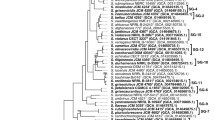Abstract
In this work, the variability of spo0A gene in the genus Geobacillus and applicability of this gene for the taxonomy within this genus were evaluated. The protein Spo0A is the master regulator of the endospore-forming process in the all endospore-forming bacteria. Geobacillus genus-specific primers GEOSPO were designed based on the sequences of Geobacillus spo0A gene available through the public databases. Inter and intraspecific variability of Geobacillus spo0A gene was determined after sequencing of the GEOSPO-PCR products. Geobacillus spo0A sequence analysis showed that three species—Geobacillus thermodenitrificans, G. stearothermophilus, and G. jurassicus—could be easily identified. Similarity between the sequences of these species and the other species were in the range of 83.3%–92.0%. In contrast, intraspecific similarity of G. thermodenitrificans and G. stearothermophilus was high—above 99.0%. Similarity of spo0A sequences of G. subterraneus–G. uzenensis species cluster also matched this interval. Intercluster similarity between G. lituanicus–G. thermoleovorans–G. kaustophilus–G. vulcani and G. thermocatenulatus–G. gargensis–G. caldoxylosilyticus–G. toebii–G. thermoglucosidasius species clusters, as well as interspecific similarity within these two clusters was in the range of the intraspecific similarity determined for G. thermodenitrificans and G. stearothermophilus. It was also determined that spo0A cannot be used as the phylogenetic marker for the genus Geobacillus.


Similar content being viewed by others
References
Brill JA, Wiegel J (1997) Differentiation between spore-forming and asporogenic bacteria using a PCR and Southern hybridization based method. J Microbiol Methods 31:29–36
Gevers D, Cohan FM, Lawrence JG, Spratt BG, Coenye T, Feil EJ, Stackebrandt E, Van de Peer Y, Vandamme P, Thompson FL, Swings J (2005) Re-evaluating prokaryotic species. Nature Rev Microbiol 3:733–739
Hilbert DW, Piggot PJ (2004) Compartmentalization of gene expression during Bacillus subtilis spore formation. Microbiol Mol Biol Rev 68:234–262
Kuisiene N, Raugalas J, Stuknyte M, Chitavichius D (2007) Identification of the genus Geobacillus using genus-specific primers, based on the 16S-23S rRNA internal transcribed spacer. FEMS Microbiol Lett 277:165–172
Kuisiene N, Raugalas J, Chitavichius D (2008) Comparative sequence analysis of 16S-23S rRNA internal transcribed spacers of the genus Geobacillus. Biologija 54:1–6
Meintanis C, Chalkou KI, KAr Kormas, Lymperopoulou DS, Katsifas EA, Hatzinikolaou DG, Karagouni AD (2008) Application of rpoB sequence similarity analysis, REP-PCR and BOX-PCR for the differentiation of species within the genus Geobacillus. Lett Appl Microbiol 46:395–401
Nazina TN, Tourova TP, Poltaraus AB, Novikova EV, Grigoryan AA, Ivanova AE, Lysenko AM, Petrunyaka VV, Osipov GA, Belyaev SS, Ivanov MV (2001) Taxonomic study of aerobic thermophilic bacilli: descriptions of Geobacillus subterraneus gen. nov., sp. nov. and Geobacillus uzenensis sp. nov. from petroleum reservoirs and transfer of Bacillus stearothermophilus, Bacillus thermocatenulatus, Bacillus thermoleovorans, Bacillus kaustophilus, Bacillus thermoglucosidasius and Bacillus thermodenitrificans to Geobacillus as the new combinations G. stearothermophilus, G. thermocatenulatus, G. thermoleovorans, G. kaustophilus, G. thermoglucosidasius and G. thermodenitrificans. Int J Syst Evol Microbiol 51:433–446
Saitou N, Nei M (1987) The neighbour-joining method: a new method for reconstructing phylogenetic trees. Mol Biol Evol 4:406–425
Stackebrandt E, Frederiksen W, Garrity GM, Grimont PAD, Kämpfer P, Maiden MCJ, Nesme X, Rosselló-Mora R, Swings J, Trüper HG, Vauterin L, Ward AC, Whitman WB (2002) Report of the ad hoc committee for the re-evaluation of the species definition in bacteriology. Int J Syst Evol Microbiol 52:1043–1047
Tamura K, Dudley J, Nei M, Kumar S (2007) MEGA4: Molecular Evolutionary Genetics Analysis (MEGA) software version 4.0. Mol Biol Evol 24:1596–1599
Trotter JR, Bishop AH (2003) Phylogenetic analysis and confirmation of the endospore-forming nature of Pasteuria penetrans based on the spo0A gene. FEMS Microbiol Lett 225:249–256
Zeigler DR (2003) Gene sequences useful for predicting relatedness of whole genomes in bacteria. Int J Syst Evol Microbiol 53:1893–1900
Zeigler DR (2005) Application of a recN sequence similarity analysis to the identification of species within the bacterial genus Geobacillus. Int J Syst Evol Microbiol 55:1171–1179
Acknowledgment
This work was supported by the grant of the Lithuanian State Science and Studies Foundation (project no. T-07253).
Author information
Authors and Affiliations
Corresponding author
Rights and permissions
About this article
Cite this article
Kuisiene, N., Raugalas, J. & Chitavichius, D. Phylogenetic, Inter, and Intraspecific Sequence Analysis of spo0A Gene of the Genus Geobacillus . Curr Microbiol 58, 547–553 (2009). https://doi.org/10.1007/s00284-009-9366-2
Received:
Revised:
Accepted:
Published:
Issue Date:
DOI: https://doi.org/10.1007/s00284-009-9366-2




